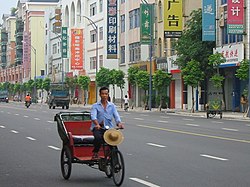This article needs additional citations for verification .(February 2021) |
Xiaolan 小榄镇 | |
|---|---|
 | |
| Nickname: Chrysanthemum City (菊城) | |
 Xiaolan is labeled '16' on this map of Zhongshan | |
| Coordinates: 22°40′20″N113°15′03″E / 22.6721°N 113.2509°E | |
| Country | People's Republic of China |
| Province | Guangdong |
| Prefecture-level city | Zhongshan |
| Area | |
• Total | 71.47 km2 (27.59 sq mi) |
| Population | 513,726 (2,020) [1] |
| Time zone | UTC+8 (China Standard) |
Wikimedia Commons has media related to Xiaolan, Zhongshan .
- ↑ <https://stats.zs.gov.cn/zwgk/tjxx/tjnj/content/post_1937766.html>
- 1 2 3 4 5 6 7 8 9 10 11 12 13 14 15 16 17 小榄镇经济社会发展总体情况简介 [Brief Introduction to the Overall Situation of Economic and Social Development of Xiaolan] (in Chinese). Zhongshan Municipal People's Government. 2020-03-25. Archived from the original on 2021-02-07. Retrieved 2020-02-07.
- ↑ 中国县域统计年鉴·2019(乡镇卷) (in Chinese). Beijing: 中国统计出版社, 国家统计局农村社会经济调查司. May 2020. p. 407. ISBN 9787503791390.
- 1 2 3 4 5 "SPECIAL REPORT-China's new migrant workers pushing the line". Reuters . 2010-07-05. Archived from the original on 2021-07-20. Retrieved 2021-07-20.
- 1 2 3 4 Soble, Jonathan; Mitchell, Tom (2010-06-18). "Labour unrest spreads at Toyota China supplier". www.ft.com. Financial Times. Archived from the original on 2021-07-20. Retrieved 2021-07-20.
- ↑ 2020年统计用区划代码和城乡划分代码(小榄镇) [2020 Statistical Division Codes and Urban-rural Division Codes (Xiaolan)] (in Chinese). National Bureau of Statistics of China. 2020. Archived from the original on 2021-02-07. Retrieved 2021-02-07.
- 1 2 3 文化之城 [City Culture] (in Chinese). Zhongshan Municipal People's Government. 2020-03-25. Archived from the original on 2021-02-07. Retrieved 2021-02-07.
| Xiaolan | |||||||||||||
|---|---|---|---|---|---|---|---|---|---|---|---|---|---|
| Traditional Chinese | 小欖 | ||||||||||||
| Simplified Chinese | 小榄 | ||||||||||||
| Postal | Siulam | ||||||||||||
| |||||||||||||
| Zhongxin Area* | |
|---|---|
| Dongbu Area* | |
| Dongbei Area* |
|
| Xibei Area* | |
| Nanbu Area* | |
* Not a formal administrative subdivision | |
